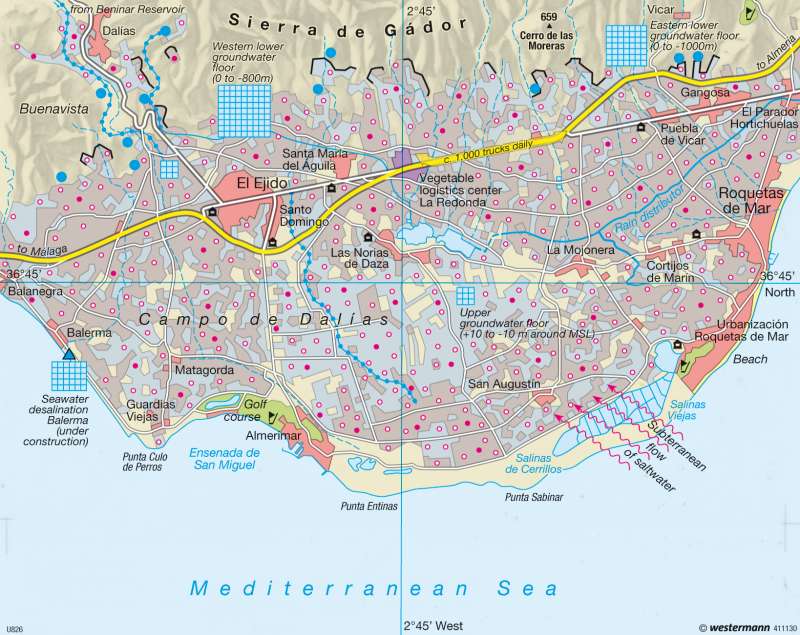El Ejido (Spain) — Greenhouse cultivation
Europe - Agriculture
978-3-14-100790-9 | Page 47 | Ill. 3

Information
The producing region of Campo de Dalías, near the town of El Ejido, is situated in the west of the province of Almería in Andalusia. It is one of those growing regions that have become transformed into a centre for fruit and vegetable cultivation.A second important district for early crop cultivation, Campo de Níjar, is situated to the east, 32 kilometres from the provincial capital of Almería. The Campo de Dalías producing region extends to the Mediterranean in the south, and is bordered in the north by the Sierra de Gádor mountain range, which reaches a height of 2,236 metres. The climate is semiarid, with average rainfall of 150 millimetres in the southern coastal area and a maximum of 600 millimetres in the high mountain ranges in the north-west.
Boom in Campo de Dalias
The most important preconditions for the enormous boom in these coastal regions are the extremely favourable climatic conditions and the supply of water. In the coastal lowland of Campo de Dalías, with some 3,000 hours of sunshine annually and average temperatures of 27 °C in summer and 15 °C in winter, fruit and vegetables can be harvested in greenhouses at a time of year when in Central Europe they are still being sown. This makes cultivation in "invernaderos" (greenhouses) extremely profitable, because the products can fetch high prices on the market. In the winter high season, some 1,000 trucks per day depart from El Ejido. 65 percent of the products are exported to EU countries. Germany is the second-largest customer after Spain; other export markets are France, Great Britain, Holland, Belgium, Italy and certain Eastern European countries such as Poland, Russia and the Czech Republic. Fruit and vegetables are also sent to Canada and the USA. But the farmers generally do not see very much of the proceeds from the sales. Prices are determined by the retailing companies. The farmers only receive one-tenth of what is earned through the retail prices.
Environmental Damage from Specialized Crops
In the active regions on the coasts, on the other hand, this development places enormous pressure on natural water and soil reserves, while at the same time greenhouse cultivation has led to heavy environmental damage. To supply Campo de Dalías with water, fossil water reserves are currently extracted from a depth of 100 metres. Water from the mountains to the north of the region is also fed to the growing areas from the Benínar Dam. The water supply deficiency amounts to some 50 hm³ per year. Today, to avoid placing an even greater burden on the groundwater reserves, the irrigation water is collected, recycled and reused. Purified sewage water, and desalinated seawater processed in the desalination plant near Balerma, is also intended to reduce the consumption of groundwater. Plans to tap the Rio Ebro in the north of Spain through pipelines have been abandoned for the time being.
Specialized crops require intensive fertilization and also need large quantities of agrochemicals. Pesticide runoff into the soil and washing out into the groundwater increasingly result in damage to the quality of the groundwater. Cultivation in monoculture and the warm and moist climatic conditions in the greenhouses favour attacks by pests and mould. In addition, substantial volumes of pesticides find their way into the groundwater from "solarisación", disinfection of the soil with the aid of sunshine. This method involves soaking the soil with water and then subjecting it to the rays of the sun. When the roof of the greenhouse is opened, the surface of the ground warms up to 60 or 70 °C. These temperatures are sufficient to kill off any undesirable germs. The result of the washing out of fertilizers is shown in high levels of nitrate pollution in the groundwater. In the three hydrological units of Campo de Dalías — Balerma-Las Marinas, Balanegra and Aguadulce — nitrate levels of 100 mg/l are recorded, far above the permitted EU tolerance level for drinking water of 50 mg/.
The province of Almería is one of the driest regions of Europe and at the same time the most intensively irrigated. The high level of water consumption in agriculture also affects the water reserves in the province. The groundwater has become severely reduced in recent decades and has also become over-salted. The southern part of the Campo de Dalías aquifer has been officially designated as "over-cultivated" since 1995. It is thus one of six groundwater regions out of a total of 21 hydrological units in the coastal regions of Spain where water consumption is too high to enable the groundwater to sustain itself. The two other existing fruit and vegetable cultivation centres in Almería — Campo de Níjar and Andarax-Almería — also suffer from this water supply deficiency. Among Andalusia's other irrigation regions, the Rota-Sanlúcar-Chipiona aquifer situated in the west of the autonomous province around the mouth of the river Guadalquivir, and the Guadiana-Ayamonte-Huelva aquifer on the Portuguese border, are also over-cultivated. Strawberries are cultivated in both regions, and also flowers in Chipiona. Out of 340 hydrological units in Spain, a total of 74, i.e. 22 percent, are affected to a greater or lesser extent by over-cultivation and salt pollution.
E. Ecker; Ü: J. Attfield




